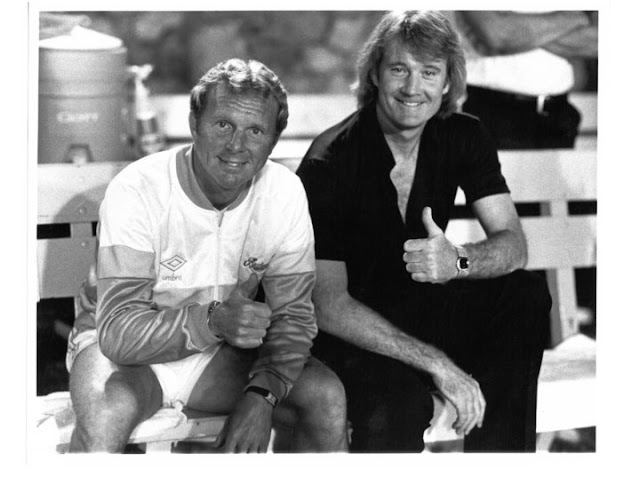May the 14th 1977 As Bobby Moore waved goodbye to his football career, walking off after his last league game for Fulham v Blackburn Rovers, it wasn't to be his final farewell to playing football as the summer before he had spent a season in the burgeoning soccer scene in the United States where he played in Texas for the San Antonio Thunder.
San Antonio played at the Alamo stadium and Moore appeared 24 times, for the Thunder including another match up against his old friend Pele as they beat the New York Cosmos 1-0, with Bobby setting up the winning goal.
The season though was not a success as their stats show that they may have won 12 games but they lost 12 as well with no draws, though at that time in the NASL there were no tied game, extra time was played then a shoot off was held to decide any games with level scores.
They finished 4th in the league, with 107 points (don't ask) failing to make the playoffs and with only an average crowd of 4,700, which was only 300 more than the season before the writing was on the wall for the club.
Sadly at the end of the 1976 after just 2 seasons of existence the franchise was moved to Hawaii and renamed Team Hawaii and with it it seems Moore's journey in America.
While with San Antonio though Bobby had 1 more international tournament to appear in, to celebrate the two hundredth year of independence of the U.S of A, a 4 team competition was organised with England Italy Brazil and a North american soccer League representative team called Team America.
The format was simple, each team played the three others with Some of the best stars of the NASL pulled on the red Jersey and swore allegiance (temporarily) to the cause
and so on May the 31st at Philadelphia's JFK stadium Bobby Moore led his Team America out against his beloved England, who were captained by QPR's Gerry Francis. The mercenaries though were out done by Revies England, wearing a strange Yellow kit for the only time, with England running out 3-1 winners (Keegan 2 T.Francis) and finishing runners up in the tournament to Brazil. Team America lost every game and would never appear again.
After his summer sojourn in Texas Moore was back at Fulham for what would be his last season yet he was not finished in America and a full year since his last game at Blackburn, and nearly 20 years since his debut for West Ham he joined Seattle Sounders for the summer of 1978.
Why Seattle, well probably the fact that his former hammers teamates Bobby Howe and Harry Redknapp were assisting the manager, Jimmy Gabriel. Seattle had reached the championship final the year before losing out to Pele's New York Cosmos and attracted good crowds, over 22,000 regularly, so in 1978 the fans were looking forward to another successful season and possibly so was Moore, but unlike his ever present season at the Thunder in Texas he managed just the 5 games, one of them again against the New York Cosmos with Seattle losing out 2-1. Strangely for Moore he didn't wear the number 6 shirt he has become so synonymous with but the number 9
Moore also appeared for the Jimmy Hill owned franchise of Detroit Express in a friendly in Austria alongside his great friend George Best, best scoring in a 2-2 draw. 

And so it seems that would be the end of Bobby Moore the footballer but there was one more stop to come,in 1983 joining up with Ex Fulham pal Rodney Marsh at Carolina Lightnin, a minor league team in Charlotte North Carolina, Moore, now 42, was his assistant on the coaching team but one night it seems injuries to the team meant for one last time in a competitive game, Bobby Moore put on his boots, crossed the white line and rolled back the years. in an interview with an american magazine, one opposition player on the night described how he found himself up against a world legend. Glenn Davis was a rookie that summer with the ASL’s Pennsylvania Stoners and recalled his shock at finding Moore in the American Soccer League i
“Carolina had so many injuries they activated Bobby Moore to play that night against us. Bobby was probably 43 years old and he obviously can’t move. He’s kicking everything and everybody that he can get close to. And we’re just going “Oh my God – it’s Bobby Moore.”
I remember we had a 2-0 lead and we absolutely crumbled in the final ten minutes with their fans going nuts. They had probably about 7,000 or 8,000 fans in this cool little stadium in Charlotte. I think it was called the Memorial Stadium. We totally collapsed as a team and lost 3-2. I remember our owner on the bus back to the hotel and screaming at one of our players. I think a lot of us were just still in shock that Bobby Moore was playing that night.”










